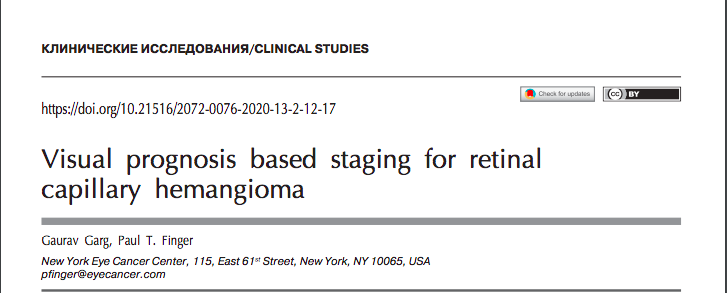The Garg-Finger Staging System for Retina Capillary Hemangioma
 Drs. Garg and Finger created the first visual acuity prognosis based staging system for retina capillary hemangioma (CRH). It appeared in the May 2020 issue of the Russian Ophthalmological Journal. Their study titled, “Visual Prognosis Based Staging for Retinal Capillary Hemangioma,” was derived from an analysis of the medical literature on Medline and PubMed. Thus, published medical evidence was collected and analyzed to create a staging system to determine the visual prognosis of eyes that are affected by retinal angiomatosis of Von-Hippel. Some of those same patients suffer from Von-Hippel Lindau disease (VHL), which is a genetic condition associated with benign and malignant tumors arising in multiple organs. The tumors seen in VHL include: hemangioblastomas, which are blood vessel tumors of the brain, spinal cord and eye as well as renal cell carcinoma. However, the most common manifestation of VHL is the retinal capillary hemangioblastoma (CRH). The average lifespan of VHL patients is 40 to 50 years. Treatment of CRH usually included observation, laser, cryotherapy, plaque brachytherapy and vitreoretinal surgery for larger CRHs and their complications.
Drs. Garg and Finger created the first visual acuity prognosis based staging system for retina capillary hemangioma (CRH). It appeared in the May 2020 issue of the Russian Ophthalmological Journal. Their study titled, “Visual Prognosis Based Staging for Retinal Capillary Hemangioma,” was derived from an analysis of the medical literature on Medline and PubMed. Thus, published medical evidence was collected and analyzed to create a staging system to determine the visual prognosis of eyes that are affected by retinal angiomatosis of Von-Hippel. Some of those same patients suffer from Von-Hippel Lindau disease (VHL), which is a genetic condition associated with benign and malignant tumors arising in multiple organs. The tumors seen in VHL include: hemangioblastomas, which are blood vessel tumors of the brain, spinal cord and eye as well as renal cell carcinoma. However, the most common manifestation of VHL is the retinal capillary hemangioblastoma (CRH). The average lifespan of VHL patients is 40 to 50 years. Treatment of CRH usually included observation, laser, cryotherapy, plaque brachytherapy and vitreoretinal surgery for larger CRHs and their complications.
Dr. Finger and Dr. Garg performed a meta-analysis for the risk factors associated with vision loss at diagnosis. The current study provides an overview of visual prognosis, factors affecting, and a new staging system to prognosticate vision retention. Dr. Finger and Dr. Garg determined that age at onset of CRH, intraocular location, and multifocality were the most important predictors of vision loss. This new Garg-Finger staging system can thus be used by both patients and their ophthalmologists to decide on the timing of treatment and the possible outcomes.









